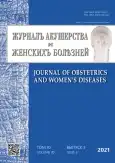胰岛素/胰岛素样生长因子在生殖器官子宫内膜异位症发病中的作用
- 作者: Florova M.S.1, Yarmolinskaya M.I.1,2, Tkachenko N.N.1, Tolibova G.K.1,2, Tral T.G.1
-
隶属关系:
- The Research Institute of Obstetrics, Gynecology, and Reproductology named after D.O. Ott
- North-Western State Medical University named after I.I. Mechnikov
- 期: 卷 70, 编号 3 (2021)
- 页面: 65-74
- 栏目: Original study articles
- URL: https://journals.rcsi.science/jowd/article/view/58194
- DOI: https://doi.org/10.17816/JOWD58194
- ID: 58194
如何引用文章
详细
论证。生长因子在外阴子宫内膜异位症的发病机制中起着重要作用。胰岛素和胰岛素样生长因子参与月经周期和妊娠早期子宫内膜的增殖和蜕膜化,可能间接影响月经逆行期间子宫内膜的侵袭和子宫内膜异位症疼痛综合征的形成。然而,关于外生殖器官子宫内膜异位症患者的子宫内膜和子宫内膜样异位中胰岛素样生长因子和胰岛素含量的文献资料较少且矛盾。
目的是研究胰岛素系统和胰岛素样生长因子1在外生殖器子宫内膜异位症发病机制中的作用。
材料与方法。进行横断面研究,包括糖代谢研究(糖耐量试验)、月经周期增殖期妇女手术材料血清胰岛素样生长因子1、胰岛素、性激素水平测定及免疫组化分析:患者有子宫内膜异位症(子宫内膜层和子宫内膜异位)和无子宫内膜异位症(子宫内膜层)。染色检测胰岛素受体和胰岛素样生长因子1的表达。然后计算受体表达的相对面积和光密度,用统计学方法分析各组间这些指标的差异。
结果。对131例患者的检查结果进行分析。这些女性在年龄和体重以及身高特征上具有可比性:101例为外阴子宫内膜异位症,30例为对照组。与对照组相比,外生殖器子宫内膜异位症患者的碳水化合物代谢的特征是刺激胰岛素水平增加2.1倍。研究小组血液中胰岛素样生长因子1的水平没有差异。各组间受体表达差异有统计学意义。外生殖器子宫内膜异位症患者子宫内膜胰岛素受体光密度降低(p=0.007),胰岛素样生长因子I受体表达水平高于对照组子宫内膜(p=0.002)。在评估胰岛素受体表达时,子宫内膜异位的中位值较对照组子宫内膜降低(p<0.001)。胰岛素样生长因子1受体在子宫内膜异位症病灶中的表达较相同患者的子宫内膜降低(p<0.001)。
结论。研究结果表明,外生殖器子宫内膜异位症患者的胰岛素/胰岛素样生长因子1系统的功能存在显著特征。这包括被刺激胰岛素水平的增加,由于胰岛素受体表达的减少而引起的子宫内膜的相对胰岛素抵抗,以及子宫内膜胰岛素样生长因子1(一种强大的生长因子)受体的增加。
关键词
作者简介
Margarita Florova
The Research Institute of Obstetrics, Gynecology, and Reproductology named after D.O. Ott
编辑信件的主要联系方式.
Email: fm.sergeevna@gmail.com
ORCID iD: 0000-0003-4569-3827
SPIN 代码: 1480-7599
Researcher ID: P-3005-2017
俄罗斯联邦, Saint Petersburg
Maria Yarmolinskaya
The Research Institute of Obstetrics, Gynecology, and Reproductology named after D.O. Ott; North-Western State Medical University named after I.I. Mechnikov
Email: m.yarmolinskaya@gmail.com
ORCID iD: 0000-0002-6551-4147
SPIN 代码: 3686-3605
Scopus 作者 ID: 7801562649
Researcher ID: P-2183-2014
MD, Dr. Sci. (Med.), Professor, Professor of the Russian Academy of Sciences
俄罗斯联邦, Saint PetersburgNatalya Tkachenko
The Research Institute of Obstetrics, Gynecology, and Reproductology named after D.O. Ott
Email: liberin@mail.ru
ORCID iD: 0000-0001-6189-3488
SPIN 代码: 9633-6701
Researcher ID: K-1734-2018
Cand. Sci. (Biol.)
俄罗斯联邦, Saint PetersburgGulrukhsor Tolibova
The Research Institute of Obstetrics, Gynecology, and Reproductology named after D.O. Ott; North-Western State Medical University named after I.I. Mechnikov
Email: gulyatolibova@yandex.ru
ORCID iD: 0000-0002-6216-6220
SPIN 代码: 7544-4825
Scopus 作者 ID: 23111355700
Researcher ID: Y-6671-2018
MD, Dr. Sci. (Med.)
俄罗斯联邦, Saint PetersburgTatyana Tral
The Research Institute of Obstetrics, Gynecology, and Reproductology named after D.O. Ott
Email: ttg.tral@yandex.ru
ORCID iD: 0000-0001-8948-4811
SPIN 代码: 1244-9631
Scopus 作者 ID: 37666260400
MD, Cand. Sci. (Med.)
俄罗斯联邦, Saint Petersburg参考
- Giudice LC, Kao LC. Endometriosis. Lancet. 2004;364(9447):1789–1799. doi: 10.1016/S0140-6736(04)17403-5
- de Ziegler D, Borghese B, Chapron C. Endometriosis and infertility: pathophysiology and management. Lancet. 2010;376(9742):730–738. doi: 10.1016/S0140-6736(10)60490-4
- Santanam N, Song M, Rong R, et al. Atherosclerosis, oxidation and endometriosis. Free Radic Res. 2002;36(12):1315–1321. doi: 10.1080/1071576021000049908
- Aarestrup J, Jensen BW, Ulrich LG, et al. Birth weight, childhood body mass index and height and risks of endometriosis and adenomyosis. Ann Hum Biol. 2020;47(2):173–180. doi: 10.1080/03014460.2020.1727011
- Hediger ML, Hartnett HJ, Louis GM. Association of endometriosis with body size and figure. Fertil Steril. 2005;84(5):1366–1374. doi: 10.1016/j.fertnstert.2005.05.029
- Taskin O, Rikhraj K, Tan J, et al. Link between endometriosis, atherosclerotic cardiovascular disease, and the health of women midlife. J Minim Invasive Gynecol. 2019;26(5):781–784. doi: 10.1016/j.jmig.2019.02.022
- Alderman MH 3rd, Yoder N, Taylor HS. The systemic effects of endometriosis. Semin Reprod Med. 2017;35(3):263–270. doi: 10.1055/s-0037-1603582
- Kvaskoff M, Mu F, Terry KL, et al. Endometriosis: a high-risk population for major chronic diseases? Hum Reprod Update. 2015;21(4):500–516. doi: 10.1093/humupd/dmv013
- Hughes CL, Foster WG, Agarwal SK. The impact of endometriosis across the lifespan of women: foreseeable research and therapeutic prospects. Biomed Res Int. 2015;2015:158490. doi: 10.1155/2015/158490
- Dupont J, Khan J, Qu BH, Metzler P, Helman L, LeRoith D. Insulin and IGF-1 induce different patterns of gene expression in mouse fibroblast NIH-3T3 cells: identification by cDNA microarray analysis. Endocrinology. 2001;142(11):4969–4975. doi: 10.1210/endo.142.11.8476
- Siddle K. Signalling by insulin and IGF receptors: supporting acts and new players. J Mol Endocrinol. 2011;47(1):R1–R10. doi: 10.1530/JME-11-0022
- Perseghin G, Calori G, Lattuada G, et al. Insulin resistance/hyperinsulinemia and cancer mortality: the Cremona study at the 15th year of follow-up. Acta Diabetol. 2012;49(6):421–428. doi: 10.1007/s00592-011-0361-2
- Yarmolinskaya MI. Genital’nyy endometrioz: vliyanie gormonal’nykh, immunologicheskikh i geneticheskikh faktorov na razvitie, osobennosti techeniya i vybor terapii. [dissertation abstract]. Saint Petersburg; 2009. (In Russ.)
- Forster R, Sarginson A, Velichkova A, et al. Macrophage-derived insulin-like growth factor-1 is a key neurotrophic and nerve-sensitizing factor in pain associated with endometriosis. FASEB J. 2019;33(10):11210–11222. doi: 10.1096/fj.201900797R
- Himsworth HP. Diabetes mellitus: its differentiation into insulin-sensitive and insulin-insensitive types. Lancet. 1936;227(5864):127–130. doi: 10.1016/S0140-6736(01)36134-2
- Kahn SE, Hull RL, Utzschneider KM. Mechanisms linking obesity to insulin resistance and type 2 diabetes. Nature. 2006;444(7121):840–846. doi: 10.1038/nature05482
- Czech MP. Insulin action and resistance in obesity and type 2 diabetes. Nat Med. 2017;23(7):804–814. doi: 10.1038/nm.4350
- Kahn SE. The relative contributions of insulin resistance and beta-cell dysfunction to the pathophysiology of type 2 diabetes. Diabetologia. 2003;46(1):3–19. doi: 10.1007/s00125-002-1009-0
- Samuel VT, Shulman GI. Mechanisms for insulin resistance: common threads and missing links. Cell. 2012;148(5):852–871. doi: 10.1016/j.cell.2012.02.017
- Kahn CR. Insulin resistance, insulin insensitivity, and insulin unresponsiveness: a necessary distinction. Metabolism. 1978;27(12 Suppl 2):1893–1902. doi: 10.1016/s0026-0495(78)80007-9
- Petersen MC, Shulman GI. Mechanisms of insulin action and insulin resistance. Physiol Rev. 2018;98(4):2133–2223. doi: 10.1152/physrev.00063.2017
- Strowitzki T, von Eye HC, Kellerer M, Häring HU. Tyrosine kinase activity of insulin-like growth factor I and insulin receptors in human endometrium during the menstrual cycle: cyclic variation of insulin receptor expression. Fertil Steril. 1993;59(2):315–322. doi: 10.1016/s0015-0282(16)55674-x
- Zhou J, Dsupin BA, Giudice LC, Bondy CA. Insulin-like growth factor system gene expression in human endometrium during the menstrual cycle. J Clin Endocrinol Metab. 1994;79(6):1723–1734. doi: 10.1210/jcem.79.6.7527408
- Sbracia M, Zupi E, Alo P, et al. Differential expression of IGF-I and IGF-II in eutopic and ectopic endometria of women with endometriosis and in women without endometriosis. Am J Reprod Immunol. 1997;37(4):326–329. doi: 10.1111/j.1600-0897.1997.tb00238.x
- Patent RUS No. 2727299/21.07.2020. Byul. No. 21. Jarmolinskaja MI, Florova MS. Sposob lechenija naruzhnogo genital’nogo jendometrioza (In Russ.). [cited 2021 Apr 25]. Available from: https://patenton.ru/patent/RU2727299C1.pdf










